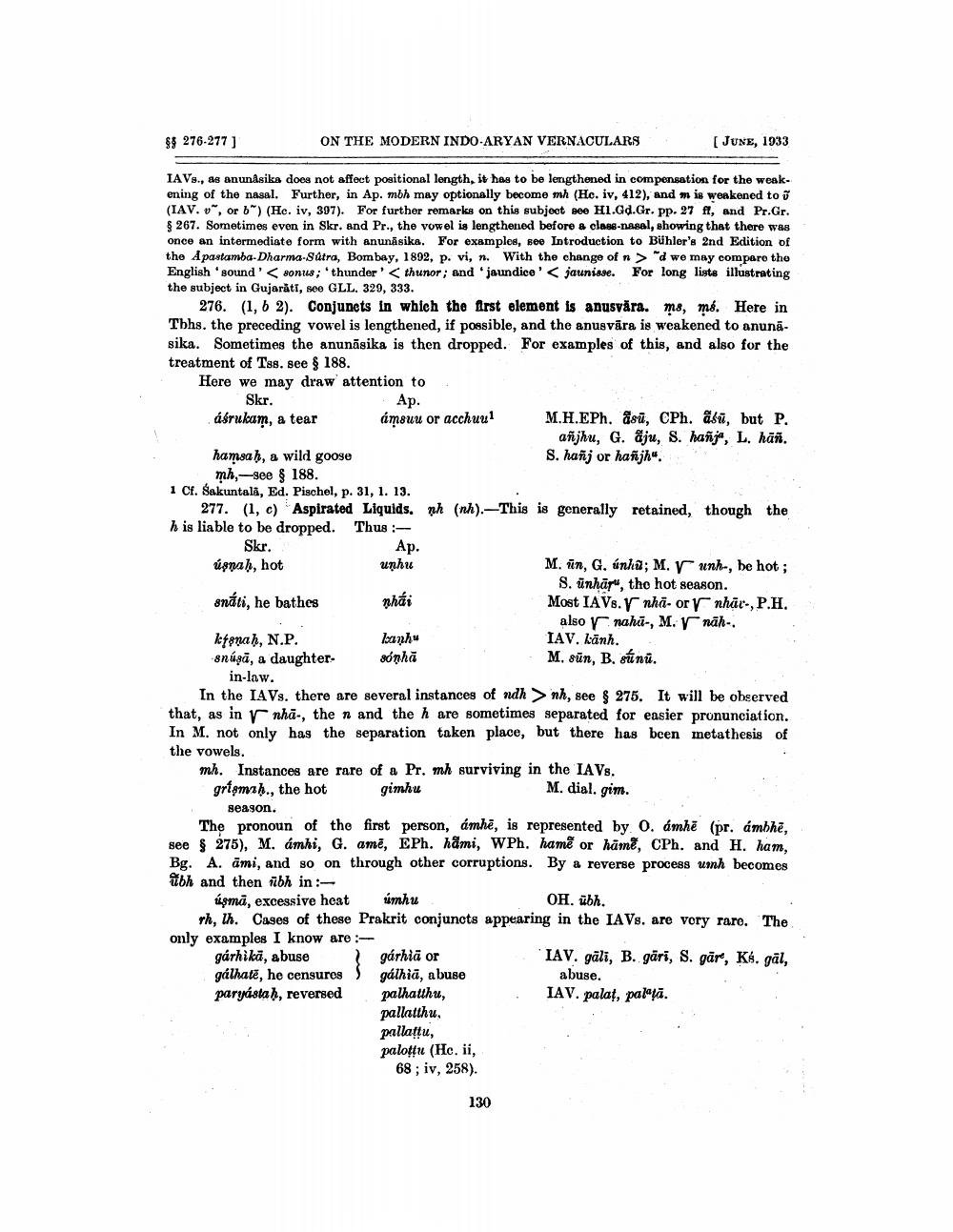________________
ON THE MODERN INDO-ARYAN VERNACULARS
§§ 276-277]
[ JUNE, 1933
IAVs., as anunâsika does not affect positional length, it has to be lengthened in compensation for the weakening of the nasal. Further, in Ap. mbh may optionally become mh (He. iv, 412), and m is weakened to (IAV. v, or b) (He. iv, 397). For further remarks on this subject see H1.Gd.Gr. pp. 27 ff, and Pr.Gr. § 267. Sometimes even in Skr. and Pr., the vowel is lengthened before a class-nasal, showing that there was once an intermediate form with anunāsika. For examples, see Introduction to Bühler's 2nd Edition of the Apastamba-Dharma-Sutra, Bombay, 1892, p. vi, n. With the change of n > "d we may compare the English 'sound' << sonus; 'thunder' < thunor; and 'jaundice' <jaunisse. For long lists illustrating the subject in Gujarati, see GLL. 329, 333.
276. (1, 2). Conjuncts in which the first element is anusvära. ms, mé. Here in Thhs. the preceding vowel is lengthened, if possible, and the anusvära is weakened to anunāsika. Sometimes the anunasika is then dropped. For examples of this, and also for the treatment of Tss. see § 188.
Here we may draw attention to
Skr. áśrukam, a tear
Ap.
ámauu or acchuul
hamsah, a wild goose
mh,-see § 188.
1 Cf. Sakuntala, Ed. Pischel, p. 31, 1. 13.
ktonah, N.P.
snúga, a daughter
in-law.
277. (1, c) Aspirated Liquids. nh (nh). This is generally retained, though the h is liable to be dropped.
Thus :
Skr. úsṇaḥ, hot
snáti, he bathes
Ap.
unhu
nhái
kanhu sónhā
In the IAVs. there are several instances of ndh>nh, see § 275. It will be observed that, as in nha-, the n and the h are sometimes separated for easier pronunciation. In M. not only has the separation taken place, but there has been metathesis of the vowels.
M.H.EPh. asu, CPh. aśü, but P. añjhu, G. aju, S. hañja, L. hañ. S. hañj or hañjh".
mh. Instances are rare of a Pr. mh surviving in the IAVs. grişmaḥ., the hot M. dial. gim.
gimhu
season.
The pronoun of the first person, ámhê, is represented by O. ámhě (pr. ámbhë, see § 275), M. ámhi, G. ame, EPh. hami, WPh. hame or hame, CPh. and H. ham, Bg. A. ami, and so on through other corruptions. By a reverse process umh becomes bh and then bh in:
gárhiä or gálhia, abuse
M. un, G. únhu; M. V unh-, be hot; S. unhāru, the hot season.
Most IAVs. V nhã- or Vnhar, P.H. also y nahu-, M. V näh-.
IAV. känh.
M. sün, B. sünü.
úsmā, excessive heat
úmhu
OH. übh.
rh, lh. Cases of these Prakrit conjuncts appearing in the IAVs. are very rare. The. only examples I know are:
gárhikā, abuse
}
gálhate, he censures paryástaḥ, reversed
palhatthu,
pallatthu,
pallaṭṭu,
palottu (Hc. ii,
68; iv, 258).
130
IAV. gāli, B. gārī, S. gäre, Ks. gāl,
abuse.
IAV. palat, palatā.




